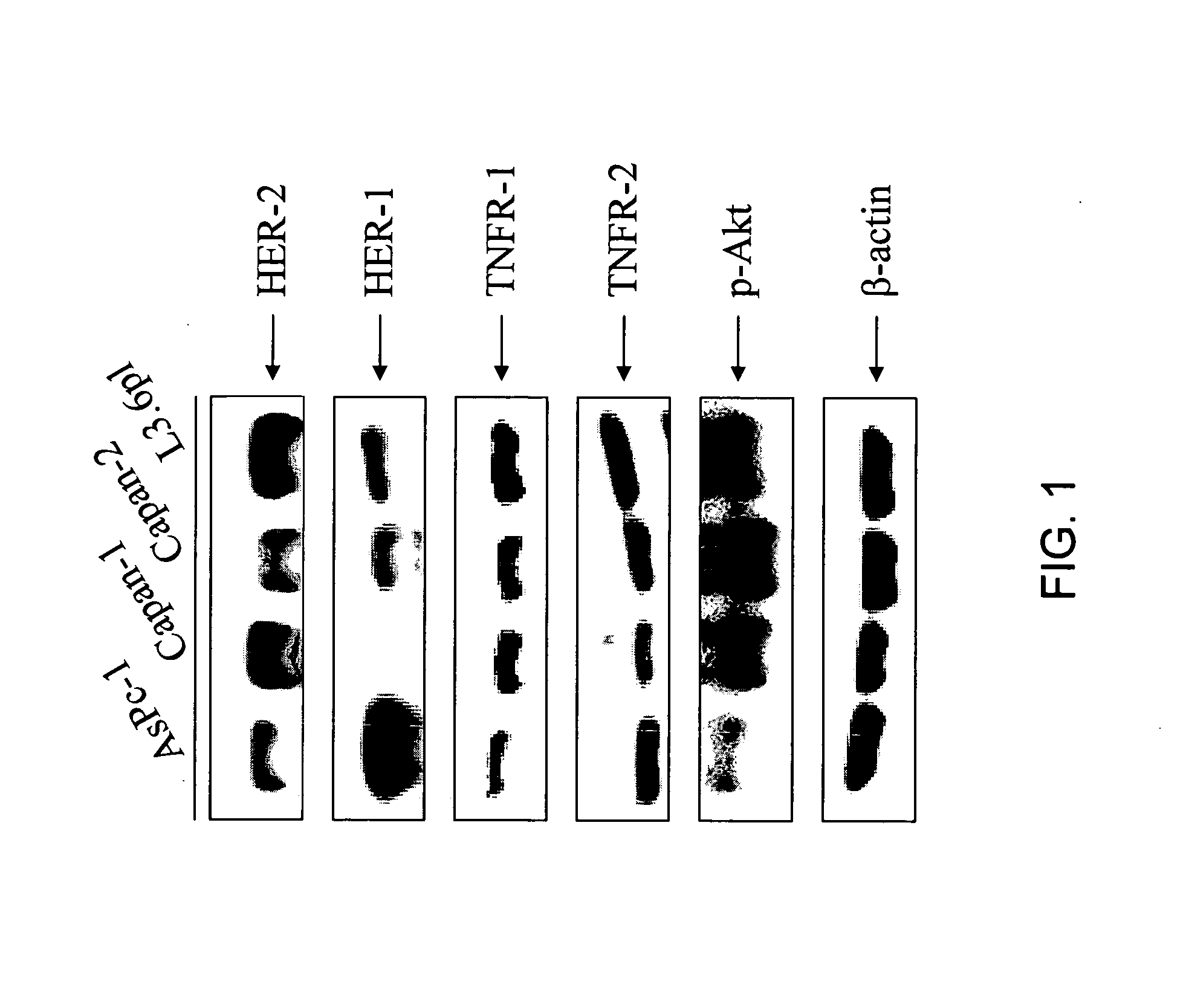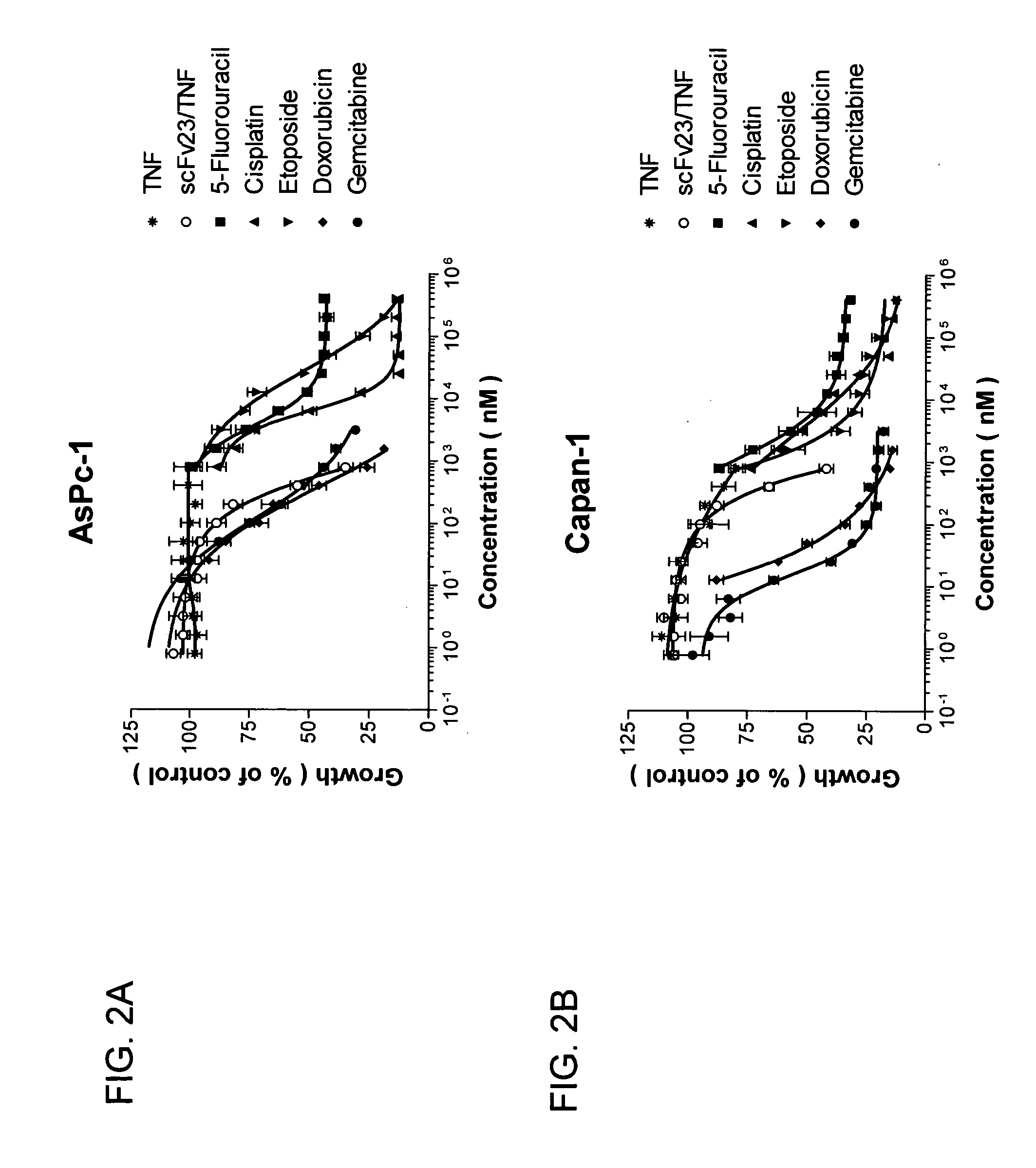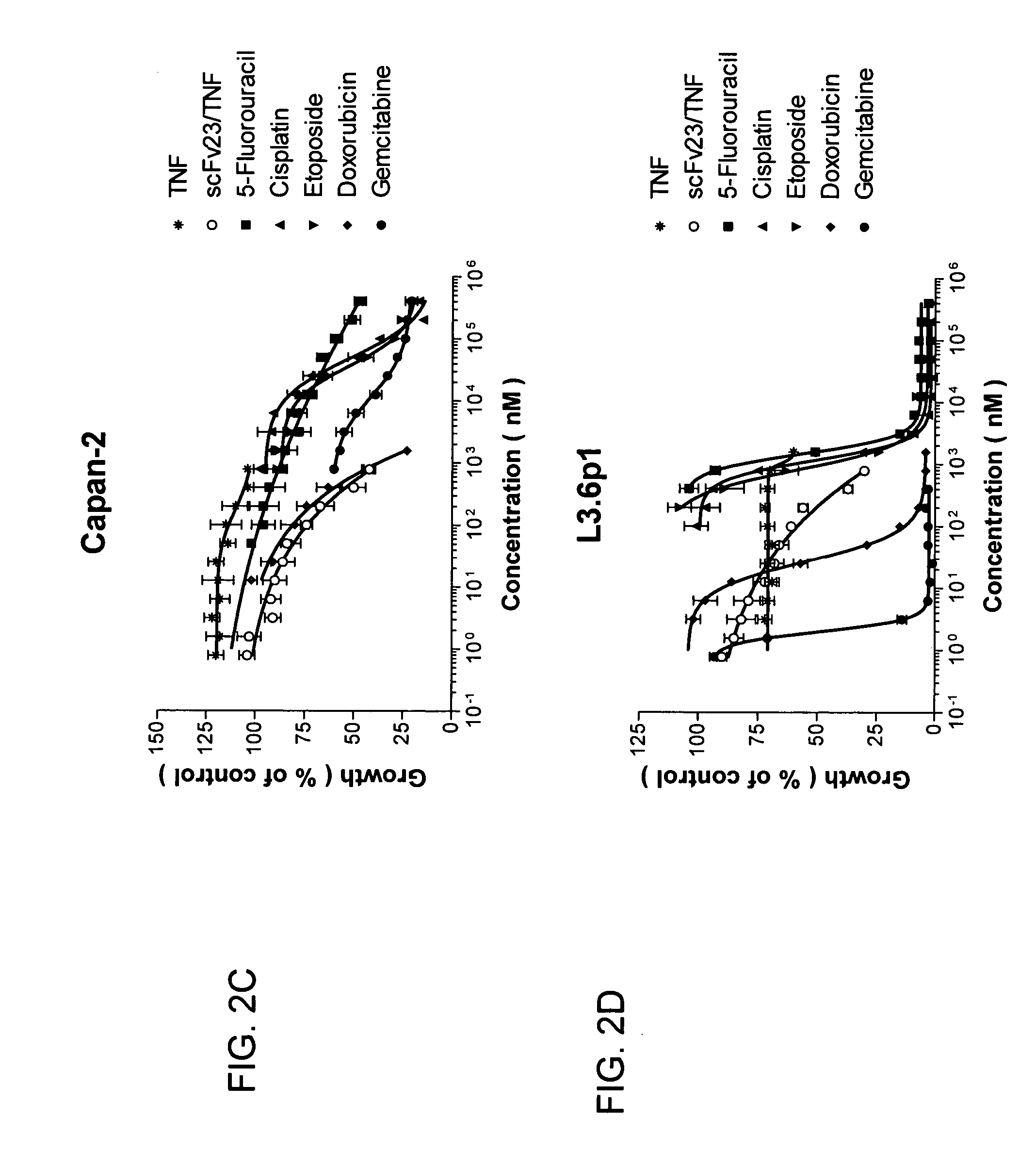Targeted chimeric molecules for cancer therapy
- Summary
- Abstract
- Description
- Claims
- Application Information
AI Technical Summary
Benefits of technology
Problems solved by technology
Method used
Image
Examples
example 1
Exemplary Material and Methods for Examples 2-8
Cell Lines and Culture
[0439] Four human pancreatic cancer cell lines (AsPc-1, Capan-1, Capan-2, and L3.6pl) were grown in Dulbecco's modified Eagle's medium (DMEM, Life Technologies Inc., Rockville, Md.) supplemented with 10% heat-inactivated fetal bovine serum (FBS), 100 units / ml penicillin and 100 μg / ml streptomycin.
Chemotherapeutic Agents and scFv23 / TNF Fusion Construct
[0440] 5-fluorouracil (5-FU) was from Roche Laboratories (Nutley, N.J.). Cisplatin and Etoposide (VP-16) were from Bristol Laboratories (Princeton, N.J.). Doxorubicin was from Cetus Corporation (Emeryville, Calif.). Gemcitabine was from Eli Lilly Co. (Indianapolis, Ind.). The scFv23 / TNF fusion construct was produced in a bacterial expression host, purified to homogeniety and assessed for biological activity as previously described (Rosenblum et al., 1995).
Antibodies
[0441] Monoclonal anti-HER-2 / neu antibody (Ab), rabbit polyclonal anti-HER-1 Ab, rabbit polyclon...
example 2
Status of HER-2 / neu, HER-1, TNFR-1, TNFR-2, and p-Akt in Four Human Pancreatic Cancer Cell Lines
[0446] HER-2 / neu has previously been found to be overexpressed in pancreatic tumor biopsy specimens and HER-2 / neu expression has been proposed as a negative prognostic marker in pancreatic intraepithelial neoplasia (Tomaszewska et al., 1998). HER-2 / neu expression was determined in four pancreatic cancer cell lines. All four pancreatic cancer cell lines (AsPc-1, Capan-1, Capan-2, and L3.6pl) expressed HER-2 / neu, TNFR-1, TNFR-2, and phospho-Akt. Compared with AsPc-1 cells, L3.6pl cells expressed 3.7 fold higher levels of HER-2 / neu, 3.1 fold higher levels of TNFR-1, and 1.6 fold higher levels of TNFR-2. Three of four pancreatic cell lines (Capan-1, Capan-2, and L3.6pl) also displayed elevated baseline levels of activated Akt. Compared with AsPc-1 cells, Capan-1 cells were found to express the highest levels of p-Akt (FIG. 1 and Table 1).
[0447] The receptor for epidermal growth factor (HER-...
example 3
Effect of scFv23 / TNF, TNF, and Chemotherapeutic Agents on Growth of Human Pancreatic Cancer Cell Lines
[0448] The ability of these chemotherapeutic agents to inhibit cell proliferation in vitro was markedly different among the four cell lines tested. All pancreatic cancer cell lines were highly resistant to the cytotoxic effects of TNF (IC50>1600 nM). 5-fluorouracil, cisplatin, and etoposide showed IC50 values between 1 and 300 mM whereas doxorubicin, gemcitabine and scFv23 / TNF were comparatively more active with IC50 values ranging between 6 and 700 nM (FIG. 2A-2D and Table 2).
TABLE 2IC50 of Various Agents Against Four ExemplaryHuman Pancreatic Cancer Cell LinesDrugAsPc-1Capan-1Capan-2L3.6pl5-Fluorouracil (5-FU)7.563001Cisplatin (CIS)144.5503.6Etoposide (ETO)282402Doxorubicin (DOX)0.320.060.50.03Gemcitabine (GEM)0.20.020.150.006scFv23 / TNF0.50.70.40.15TNF>1.6*>1.6*>1.6*>1.6*
*Highest concentration achieved.
[0449] The IC50 values were determined after 72 hr of exposure to the drugs...
PUM
| Property | Measurement | Unit |
|---|---|---|
| Volume | aaaaa | aaaaa |
| Volume | aaaaa | aaaaa |
| Volume | aaaaa | aaaaa |
Abstract
Description
Claims
Application Information
 Login to View More
Login to View More - R&D
- Intellectual Property
- Life Sciences
- Materials
- Tech Scout
- Unparalleled Data Quality
- Higher Quality Content
- 60% Fewer Hallucinations
Browse by: Latest US Patents, China's latest patents, Technical Efficacy Thesaurus, Application Domain, Technology Topic, Popular Technical Reports.
© 2025 PatSnap. All rights reserved.Legal|Privacy policy|Modern Slavery Act Transparency Statement|Sitemap|About US| Contact US: help@patsnap.com



